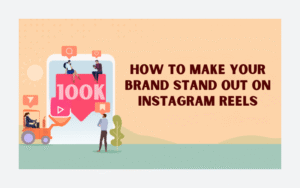Such short videos have gone beyond an emerging trend to become a key player in the digital content landscape. Now, there is not a single doubt that the short-video format has been adhered to by platforms such as TikTok, Instagram Reels, YouTube Shorts, and, more recently, LinkedIn and Pinterest, which indicates that in 2025, not creating short-format video will not allow you to be a meaningful part of the social media experience. It isn’t a choice anymore; it is a necessity of growth, interaction, and brand relevance.
In the era in which attention is money, short-form video caters to the audience at the point of need, concentrating on fast, exciting, easily digestible materials that educate, entertain, or inspire-or frequently all of it-in just 5 to 30 seconds. Short-form video content does not merely reach people; it is algorithmically preferred, making mobile-first behavior a deep-rooted customer media-consuming behavior. Unless your content plan emphasizes this form of media presentation, you run the risk of being crushed flat under the weight of a tsunami of makers who understand the importance of the medium.
However, it is not always enough to take part in trends to achieve success in short-form video. It is something meaningful yet timely that makes your audience feel good about what you are doing, at the same time, achieving what you want to. So, why is the short-form video going to be the most essential content in 2025, and how can this tool be utilized to lead to further social development?
The Science Behind Short-Form Video Success
Short-form video is powerful because it can distill a message down into a digestible, albeit sometimes emotional and always limited in length, message. Neurologically, the brain is programmed to respond to movement, faces, and narrative- three things that short-form video can provide in quick succession. It leverages the dopamine feedback cycle, which gives users a constant dose of enjoyable, new material at the lowest possible input.
The viability of short-form videos cuts across all demographics; however, Gen Z and Millennials dominate them and are leading the new generation of digital engagement. These users are not just content consumers, but are also creators, remixers, and sharers. The short-form video is viral in this participatory culture. The flow promotes interactivity, remixing, and rapid spreading of trends.
On such platforms as TikTok or Reels, algorithms are created to amplify the content that can attract users in the shortest time possible. This is the power of the first three seconds, a catchy audio track, a twist in visual arrangement, all these so-called micro-moments are what the performance is all about. Although longer-form content is not dead and can still serve to facilitate deeper stories or tutorials, the short-form video is the top-of-funnel attraction: what can draw viewers in with urgency.
The Rise of “Edutainment” and Bite-Sized Learning
The emergence of so-called edutainment, or entertainment providing an educational element, is one of the greatest changes in short-form video in recent years. In 2025, users do not spend time scrolling through social media only to be entertained; they want instant, practical knowledge. That could be a 30-second lesson on how to do something, an eye-opening science fact, a money-saving tip, or a productivity hack, just make it simple and fun.
The trend has given an opening to professionals and educators, and brands that previously enjoyed long-form blogs or webinars to reach a wider audience. One of the techniques that a mental health expert would present to 20-second breathing. A chef may demonstrate a quick food hack. A SaaS business might show a feature that is not obvious on its platform. These clips are easy to consume, highly shareable, and great on-ramps into deeper content ecosystems.
Distilling is what creators need to learn to succeed in this space; a father/mother should not feel obliged to share everything with the child, and more precisely, to share it out. It is not even a matter of getting rid of depth-it is simply a matter of making things obvious and speedy. An effective short-form video conveys a single idea, a single message, or a single call to action in a persuasive way. When done regularly, it generates trust, authority, and brand memory.

Authenticity Over Polish
Short-form content lives on being authentic, unlike traditional branded videos that require a high production value. By 2025, perceptions of audiences prefer a sense of realness over civility. Only footage recorded with the help of a smartphone in vertical video, incidental lighting, gut instinct comments, and snippets of the process read naturally, are easy to connect to, and are believable.
It is particularly succinct in the case of personal brands and small companies. Creators who do not have the means to produce cinematic-quality videos can still amass immense audiences just by being present often and being true to themselves. Selfie Face-to-camera Advert, too, is a format that has turned out to be the king in terms of being a form that does not feel like a piece of advertising but rather a discussion.
The brands have also been forced to adapt. One polished video a month is not enough anymore. People desire more frequent touchpoints, whether in a more scruffy form or not. Indeed, excessive and sometimes not authentic enough videos may seem out of touch, particularly in the younger user groups. Rather, the brands are making a name in the market when they give creators, employees, and micro-influencers the charge to create short-format videos, which fit their tone and values.
What matters more in this age is being there more than being perfect. Consistently and imperfectly appearing creates better ties with the audience than holding back something till it is perfect.
Short-Form Video Fuels the Algorithm
The grandeur of social algorithms prioritizing short-form video also represents another significant factor as to why the modality will be vital in 2025. Social media sites are also putting in effort in short-form discovery engines, to enable content to be promoted based on behavior and follower count. It allows small creators to become viral and brands to grow their organic reach, so long as the content is interesting.
Where such sites exist as TikTok, YouTube Shorts, and Instagram Reels, a list of videos that is displayed on the For You Page or Explore Feed is supported by AI and user habits more so than by relationships with followers. In case your video allows people to watch it again and again, to comment, to share it, the algorithm will present it to more people. This is a reinforcement process, whereby material, which is performing gains, increases visibility and results in fast growth.
Due to this reason, brands and makers are no longer finding their priority in posting regularly but rather in becoming strategic about their posts. Each video is a test of audience mentalities: What will make them not scroll the page? How is emotion triggered? What strikes the attention?
The success on these platforms is under the notion of attention economics, that is, what people may care about within the context of seconds. The short-form video compels creators to become more incisive, quicker, and more purposeful with the delivery.
Cross-Platform Scalability
Scalability is one of the greatest opportunities of short-form video. One video can be utilized on several platforms with little editing. An Instagram Reel, YouTube Short, Pinterest Idea Pin, or any combination of all of the above may utilize the same TikTok clip, not to mention that one could embed the piece into LinkedIn or email marketing.
Such cross-platform flexibility optimizes the longevity and distribution of the content. The ability to do more with less in a content-hungry world is a huge advantage–especially when you are an individual producer or when you are a team of marketers working with a very limited budget.
The best solution is to slightly adapt the content to be modified to each of the platforms in terms of its tone and expectation of the audience. As an example, the LinkedIn platform can be associated with a more professional, thought-leadership tone, whereas TikTok could be used to entertain, as well as employing the elements of culture. The principle is the same, but the context adapts the principles.
Conclusion
Short-form video will not go away soon, but will define the ages of the modern digital world. In 2025, it is the convergence of attention, accessibility, authenticity, and algorithmic reach. Vertical video has become a necessity for those creators, brands, and marketers who want to grow, engage, and monetize.
Brevity is not the only issue in great content, but also how well you make the situation understandable, innovative, and relational. Short-form video may be short, but when implemented strategically, it can create change, catalyze a community, and generate true business. When executed properly, it is agile, scalable, and incredibly human.The market to exploit is huge, a n so is the competition. No longer is the question whether short-form video works. It is a matter of whether you are prepared to exercise it on purpose, often, and imaginatively enough.
In an era of constant discovery that happens with a swipe, short-form video is how you make them stop, watch, and remember.










